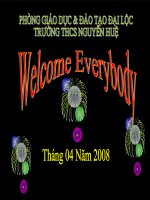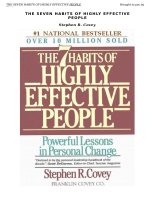Seven wonders of communication
Bạn đang xem bản rút gọn của tài liệu. Xem và tải ngay bản đầy đủ của tài liệu tại đây (12.88 MB, 84 trang )
Seven Wonders of
C
o
mm
u
n
iCatio
n
Donald Cleveland
Seven Wonders of
CommuniCation
In every age, science and technology
have played an important role in advancing
human civilization. From architecture to
engineering, communication to transportation,
humans have invented and developed
extraordinary wonders.
The myriad of methods we have used
to communicate with each other throughout
history has changed our society. Today’s
tools of communication have the power to
spread information across the planet in sec-
onds. Millions of people are now intercon-
nected through advancements in technology.
In this book, we’ll explore seven won-
ders of communication, capturing the
journey from the throaty grunts of our
ancestors that formed our first language; to
hieroglyphs and the development of writ-
ten communication; to telephones and cell
phones, the World Wide Web, and robot
communication. Along the way,
we’ll see how visual technologies enhanced
our communication, how the speed of com-
munication keeps accelerating, and what
challenges the future holds. We’ll also learn
the stories of how and why these communi-
cation advancements became important to
the world.
ReinfoRced binding
1
Tell Me Something: The Incredible Human Language
Donald Cleveland
TwenTy-FirsT CenTury Books
Minneapolis
Seven Wonders of
CommuniCation
2
Seven Wonders of Communication
Copyright © 2010 by Donald Cleveland
All rights reserved. International copyright secured. No part of this book may be reproduced, stored in a retrieval system,
or transmitted in any form or by any means—electronic, mechanical, photocopying, recording, or otherwise—without the
prior written permission of Lerner Publishing Group, Inc., except for the inclusion of brief quotations in an acknowledged
review.
Twenty-First Century Books
A division of Lerner Publishing Group, Inc.
241 First Avenue North
Minneapolis, MN 55401 U.S.A.
Website address: www.lernerbooks.com
Library of Congress Cataloging-in-Publication Data
Cleveland, Donald, 1935–
Seven wonders of communication / by Donald Cleveland.
p. cm. — (Seven wonders)
Includes bibliographical references and index.
ISBN 978-0-7613-4240-3 (lib. bdg. : alk. paper)
1. Telecommunication—Juvenile literature. 2. Multimedia communications—Juvenile literature. I. Title.
TK5102.4.C554 2010
621.382 dc22 2009020319
Manufactured in the United States of America
1 — DP – 12/15/09
To Ana D.Cleveland—
you are always there when I need you!
eISBN 978-0-7613-5988-3
3
Tell Me Something: The Incredible Human Language
Introduction —— 4
the inCredible human language —— 7
telephones then and now —— 17
Cameras—from blaCk box to digital —— 27
the magiC of television —— 35
the personal Computer —— 43
the world wide web —— 55
robot CommuniCation —— 63
Timeline —— 70
Choose an Eighth Wonder —— 72
Glossary —— 73
Source Notes —— 74
Selected Bibliography —— 75
Further Reading and Websites —— 76
Index —— 78
Contents
ebooksdownlodrace.blogspot.in
4
introduCtion
People love to make lists of the biggest
and the best. almost twenty-five hundred years ago, a greek
writer named herodotus made a list of the most awesome
things ever built by people. the list included buildings,
statues, and other objects that were large, wondrous, and
impressive. later, other writers added new items to the list.
w
riters eventually agreed on a final list. it was called the
s
even wonders of the ancient world.
The list became so famous that people began imitating it. They made
other lists of wonders. They listed the Seven Wonders of the Modern
World and the Seven Wonders of the Middle Ages. People even made lists
of undersea wonders. In these pages, you will find a list of Seven Wonders
of Communication.
From the moment we are born, we try to communicate. We start by
crying and flopping our arms and legs. Then we start gurgling. Before long
we realize that people around us have funny noises coming out of their
mouths and these noises mean something important. We try to make the
same noises. Welcome to the wonders of communication.
5
American mathematician Claude
E. Shannon (left) created Shannon’s
Model of Communication.
what is CommuniCation?
Communication is the process by which most living things exchange
information. In the 1940s, a mathematician named Claude E. Shannon gave us
a picture of what communication is. His model became known as Shannon’s
Model of Communication. It looked like this:
The communication source is where the information comes from. The
information is then encoded. When someone talks or writes, that
person’s thoughts are “encoded” into language. The message
then goes through a channel. In this case, the channel
is air. At the receiving end, the message is decoded.
If someone is talking or writing it, that person’s brain
decodes the language in order to understand it. The
destination is the person receiving the message. Noise is
anything that interferes with the communication process.
Noise could be poor handwriting.
As we move through the following chapters on
the Seven Wonders of Communication,
keep Shannon’s idea in mind. This is what
communication is all about.
the inCredible
Human Language
These prehistoric cave paintings were found in a cave
in Africa. Paintings from thousands of years ago help
scientists discover how written language was developed.
7
the inCredible
Human Language
Y
ou are able to read this book because
you have the greatest communication wonder of all times
in your head. this is human language. it’s where all the
wonders of communication begin.
Language can be spoken or written. Communicating vocally (speech)
is a complicated process involving many parts of the body. Often speech
includes body language such as jumping up and down and waving a fist.
Language can also be written. This allows us to communicate across
distance and time. American author Mark Twain wrote in the nineteenth
century about the adventures of Tom Sawyer and Huckleberry Finn.
Hundreds of years in the future, people will read what he wrote, perhaps
even citizens from other planets.
Seven Wonders of Communication
8
Language is nature’s communication
system for humans. It is a perfect example
of Shannon’s communication model. The
author of this book is a source. My brain
encoded my thoughts into language. I
entered them into my computer. The
channel in this case is the publisher of the
book. My messages passed through a lot
of people before becoming a book. Finally,
someone opened the book and began to
read. Word by word, a brain decoded the
language.
This process allows me to share my
thoughts. In the Shannon model, I am the
source, and the reader is the destination.
Language is the communication tool we
both use to communicate.
origins of language
No one knows for sure how language
developed. Most scholars believe it
developed along with the evolution of
humans. No caveman woke up one
morning and said, “Today I am going to
invent talking.” As humans evolved, their
brains developed the abilities to acquire
language. At the same time, sound-making
parts developed in their throats and
mouths.
While the physical parts developed
in humans, their social awareness grew.
Humans realized that the better they
communicated with one another, the more
successful they would be.
who is
Noam
Chomsky?
Linguistics is the scientific
study of language. Linguists are
people who study the origins,
rules, and workings of language.
Noam Chomsky (above) is a
famous linguist. In the 1950s, he
pioneered new thinking about
how people acquire language.
Chomsky says we are born with
the ability to learn a language. This
ability works the same way for
everybody. It makes no difference
if the language is English, Spanish,
or something else.
9
The Incredible Human Language
how language
w
orks
A language begins with sounds and
symbols. The basic unit is the word.
A word is a string of sounds or
symbols. Individual words have specific
meanings. Real language begins when
people string words together.
A language can string words
together in thousands of different ways.
Each way has to follow certain rules to
be understood. Grammar is the set of
rules for correctly speaking and writing
a language. Syntax is a part of grammar.
The rules of syntax determine the
way words are strung together in a
sentence. Semantics is the meaning
of the words. For example, bear may
mean “to put up with something
unpleasant.” But bear may also mean “a
big, hairy animal.”
physiCal
m
eChanisms of
h
uman speeCh
The physical act of speaking
requires the exact coordination
of a number of body parts. All of
them are commanded by the brain.
Neuroanatomists are scientists who study what different parts of the brain do.
They have discovered what parts of the brain control speech.
Speech requires at least one hundred different muscles working as a team.
The team follows orders from regions of the brain. The process begins with
the lungs expelling air. This air passes through an organ in the throat called the
human speeCh
Mechanisms
The mouth and throat are for more
than eating. Nearly one hundred
muscles in the lungs, throat, mouth,
and nasal cavity are used to produce
human speech.
All these organs and body
tissues contribute
to making the
sounds and
words of
speech.
10
Seven Wonders of Communication
larynx. The larynx changes the size and
shape of its opening to make different
sounds as the air passes through it. The
shape determines if the sound is high-
pitched, low-pitched, hard, or soft. The
lips, tongue, teeth, and jaw put the final
touch on the sound to get the words
just right.
the invention of
w
ritten language
The dawn of graphic (written)
communication began more than
thirty-two thousand years ago when
prehistoric humans drew pictures and
paintings on cave walls. Explorers have
found these caves in Spain, France,
Great Britain, and other countries.
Over time, small pictures began to
represent words. A picture of a snake
meant the word snake. From this, the
ancient Egyptians invented a form of
writing called hieroglyphics. A string
of pictures expressed a complete
thought. A long string of hieroglyphics
might tell a story.
The Sumerians and Babylonians, in
what is modern-day Iraq, started using
wedge-shaped characters that stood for
speech sounds. We call this cuneiform
writing. Writers placed the cuneiforms
in a certain order to mean certain
ideas. Strings of cuneiforms resemble
our present-day sentences. Cuneiform
broCa and
Tan! Tan!
Broca’s area is a part of the brain
that deals primarily with speech
production. Damage to this area
causes people to have problems
speaking clearly. Paul Broca (below)
was a French neuroanatomist in the
mid-1800s. He identified the speech
area by working with a patient the
hospital staff nicknamed Tan. They
called him this because “Tan! Tan!”
was the only word he could say
clearly. Disease had badly damaged
Tan’s Broca’s area.
11
Tell Me Something: The Incredible Human Language
writing was a major step toward the invention of modern alphabets. As the
years passed, alphabets developed in many forms all over the world.
To write, there has to be something to write on and to write with. Early
humans wrote on rocks, wood, skins, and cloth. Ancient Egyptians pressed
out papyrus plants to make a paperlike writing material. In
a.d. 104 in China,
a man named Tsai Lun invented paper made out of wood fiber. Over the
centuries, this became the most common writing material.
Early people wrote with sharpened stones, bones, or sticks dipped in dye
or some other colored liquid. The Greeks introduced the earliest writing tool
similar to a pen. It was a stylus made of metal, bone, or ivory. Quill pens
appeared around
a.d. 700. Writers made quill pens by sharpening the ends
These hieroglyphics were found in a temple in Egypt. Ancient peoples used a series of pictures to tell a
story or give information.
12
This painting by a
Spanish artist shows
a priest using a quill
pen. The painting is
from the seventeenth
century.
of bird feathers. The feathers of geese, hawks, owls, and turkeys made the
best pens.
The first fountain pen appeared in the mid-tenth century. The caliph (ruler)
of Egypt ordered his staff to invent a writing tool that would hold ink and feed
it to the writing tip. Gravity pulled the ink down from a storage area. When the
storage area ran dry, the writer added more ink to it. The following centuries
brought various improvements on the fountain pen.
“When we study human language, we are
approaching what some might call the ‘human
essence,’ the . . . qualities of mind that are, so
far as we know, unique to man.”
—Noam Chomsky, 2006
13
In 1500 the English invented
pencils. In 1938 a Hungarian editor
named Laszlo Biro made the first
ballpoint pen. It was not as messy as
a fountain pen. And it didn’t need
to be refilled.
Written language was a
remarkable achievement. Equally
remarkable is our modern ability
to capture and preserve spoken
language through technology, such
as recordings. Together, written
language and recorded spoken
language will make our thoughts
and reflections of life available for as
long as the world exists.
printing
The invention of the printing
press changed communication. In
the eleventh century, in China, a
man named Bi Sheng invented a movable type device made of wood. In the
thirteenth century, the Koreans invented a movable type device made of metal.
Movable type allows the printer to move letters around and reuse them.
Before this invention, a printer had to carve all the letters and words for a page
or group of pages from a single block of wood. The printer made copies, but
the wood soon wore out, and new blocks had to be carved. It took a long time
to print anything, and few copies could be made. To print another book, the
printer had to carve other pages. Movable metal letters changed that.
“What gunpowder did for war, the printing press
has done for the mind.”
—Wendell Phillips, Boston lawyer, 1863
The Incredible Human Language
Hungarian Laszlo Biro designed the ballpoint pen in
1938. He worked with his brother, a chemist, to make
the pen.
14
Seven Wonders of Communication
We give credit to a German, Johannes
Gutenberg, for inventing a movable type
printing press for the Western world in about
1450. His most famous printed work was
the Gutenberg Bible.
Human communication changed in the
years after Gutenberg. His press provided
many inexpensive copies of books. This
meant that the written word could be spread
around the world. Having books available
made people everywhere want to read.
wonders of
l
anguage
One of the real wonders of language is that it is forever changing. It changes to
reflect the world around us and the world in our heads. We adjust our language
to communicate better. Language is alive and strong. Many new words will
appear in this century. Many other words will become outdated. Will there ever
be a universal language? One language for everyone? Who knows?
an expensive
Bible
The Gutenberg Bible was
not the first book Johannes
Gutenberg printed with his
movable type printing press in
the 1400s. But it is his most
famous. Twenty-one complete,
perfect copies still exist. The
last time a complete Gutenberg
Bible was for sale was in 1978.
It sold for $2.2 million.
Top: In this
painting, Johannes
Gutenberg
examines a page
off the first printing
press in the mid-
1400s. Left: These
pages are from a
Gutenberg Bible
printed in 1455.
Telephones
then and now
These telephone
operators direct calls
in the early 1900s.
17
Your friend is on vacation and is
standing on the great wall of china. you flip open the
little device in your hand. you scroll quickly to a familiar
number. you push a button. you hear some buzzing, a click
or two. in a few seconds, your friend says, “hey, there!”
from 12,000 miles (19,312 kilometers) away. welcome to the
wonders of the telephone.
18
Seven Wonders of Communication
it has a system
Modern phones are part of
an incredible communication
system. It begins with the
telephone in your hand. The
phone is an electronic tool
that encodes your voice, text
message, or images into an
electrical current. The current
moves through a wire or a radio
to a receiving phone.
Telephone systems connect
phones into networks to make
them useful. These systems carry
thousands of conversations at
the same time. The wonder is
how the system manages to get
so many messages from senders
to receivers with such great
reliability and clarity.
When you make a call, the
computer in the system checks the
number to see if it is valid. Then it figures
out the location of the equipment that
handles the phone you want to talk to.
It alerts the computer in charge at that
location. The computer at the receiving
end causes the receiving phone to ring.
Someone answering the phone
causes the computers on both ends to
open up a circuit channel between the
two phones. You have your own private
channel in the system. When you turn
off the phone, the computers shut down
the channel.
Alexander Graham Bell (right front) makes the first call
on the New York to Chicago telecommunications service in
1892. Bell invented the telephone in 1876.
on Hold
The inventor of the phone,
Alexander Graham Bell, and his
assistant, Thomas Watson, were
working on improving the phone.
Bell was talking on the phone
when someone asked to talk with
him. Bell handed the phone to
Watson and said, “Hold this,” while
he went to another room. Thus was
born the term “putting someone
on hold.”
how telephones
w
ork
Telephones convert sound to
electrical current and send the
current to a receiving phone.
The receiving phone converts
the electrical current back into
sound. Early phones had a
mouthpiece containing a thin
metal plate that vibrated in sync
with the sound waves spoken
into the phone mouthpiece. The
thin plate was like an eardrum.
Female telephone operators work at the National
Telephone Company in 1900.
all done
by Hand
Early phone systems were
exchanges operated by people
sitting in front of switchboards.
They answered calls and plugged
and unplugged wires to connect
customers. In the beginning, these
operators were boys. The boys
were often rude to customers,
so the phone exchanges replaced
them with young women. The
young women were more polite. In
1891 Almon B. Strowger invented
an automatic telephone exchange.
His company installed one in
Kansas City, Missouri. Still, manual
systems remained in use for
decades more.
20
Seven Wonders of Communication
The vibrations of the plate caused electrical current to vary in strength and
wavelength to reflect the changing sound waves.
Sound waves are invisible movements caused by vibrations. The sound
wave vibrations push their way through air or another medium. Fast vibrations
cause you to hear high-pitch sounds. Slow vibrations cause you to hear low-
pitch sounds.
The telephone converted sound waves into electrical current. The electrical
current then sped along through a wire to the other phone. At the receiving
end, the process went into reverse. The incoming current caused a metal plate
in the earpiece to vibrate. The vibrating thin metal plate produced sound
waves that the human ear could pick up.
These early telephones worked by what is called an analog process.
The analog process used the characteristics of the sound to convert it to an
electrical current that has a similar pattern. When the sound changes, the
electrical current changes. For example, if the sound rises in pitch or tone, the
electrical current changes the same way. The patterns in the electrical current
are an analog of the patterns in the sounds.
from analog to digital
Electronic communication devices still depend on the basic principle of
converting sounds into electrical pulses at the sending end. Then they convert
them back to sound at the receiving end. A new way of doing this is called
digital processing.
With digital processing, zeros and ones represent the patterns of the sound
waves, text, or images. A very large set of zeros and ones record the patterns.
For sound, a specific set of zeros and ones represent the specific characteristics
of sound, such as pitch. The receiving computer reads the sets of zeros and
ones. It reproduces them as sounds in its speakers.
“The great advantage [the phone] possesses over
every other form of electrical apparatus consists in the
fact that it requires no skill to operate the instrument.”
—Alexander Graham Bell, 1876
21
Telephones have gone through dozens of style and technical
changes. In the 1920s, telephones had separate hearing and
speaking pieces (middle left). Later that decade, telephones
with one handpiece for both listening and speaking were
introduced (middle right). Phones had rotary dials for
making calls for many decades. In the 1970s, touch-tone
dialing was introduced. And modern phones have a touch-
tone keypad, as well as answering machines and cordless
receivers (bottom left).
many
Inventors
Many different people worked on
developing the telephone. One
of these inventors, Elisha Gray,
actually developed a telephone
about the same time as Bell. But
Bell beat him by a few hours in
filing for a patent for it. The famous
genius inventor Thomas A. Edison
also worked on developing the
telephone, such as the one at left.
22
Seven Wonders of Communication
Telephones and phone systems
are moving into a digital world
because digital technology has
better voice quality and less noise.
Digital technology has more ways
for transmitting and receiving. For
example, modern technology squeezes
digital signals into a smaller space. This
allows many more phone signals to
be sent at the same time over a single
channel. Analog signals use a lot of
space in a channel.
Cell phones
The cell phone in your backpack is
really a radio. It is a powerful radio
with a small transmitter, receiver,
microphone, speaker, antenna, and
battery. Cell phones can be either
analog or digital, though most new
ones are digital. Either way, they work
in a similar way:
• The phone translates your
messages into an electrical
current.
• The radio transmitter in the
phone sends the current over the
air as a radio signal.
• The radio receiver in the
receiving phone accepts the
incoming radio signal.
• The receiving phone converts the
received signal into messages that
humans recognize.
fun faCt:
No Sound
The moon has no air or water.
Therefore, there is no sound on the
moon. There is nothing for the sound
waves to move through. Also, to have
sound, something must hear the
sound—such as your ears.
The cellular batteries used in cell phones were
developed in the 1940s. But it wasn’t until 1983
that the Federal Communications Commission, a
government agency, approved the first mobile phone
for use in the United States.
23
Cell phones use cell sites to help send messages. Towers at the cell sites
are equipped with many big antennas. When you call your friend standing
on the Great Wall of China, your cell signal hops from antenna to antenna.
Communication companies have placed cell sites all around the world. Usually,
these sites are 20 to 30 miles (32 to 48 km) apart. If your cell signal is traveling
Left: This cellular communications tower allows users to send and receive cell phone signals. Right: This
modern cell phone tower is disguised as a palm tree.
“I have always wished that my computer would be as
easy to use as my telephone. My wish has come true.
I no longer know how to use my telephone.”
—Bjarne Stronstrup, computer scientist at Bell Labs, 1979









